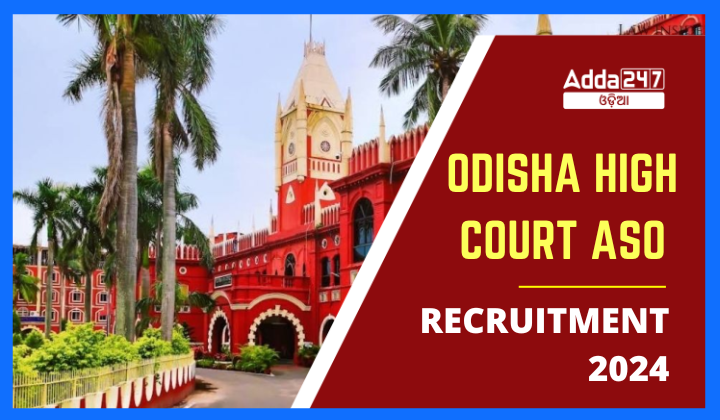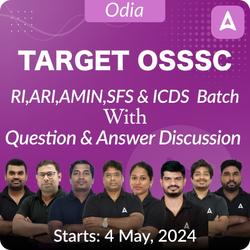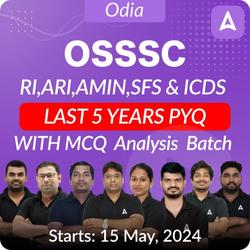
ଓଡ଼ିଶା ହାଇକୋର୍ଟ ASO ନିଯୁକ୍ତି
ଓଡିଶା ହାଇକୋର୍ଟ ASO ନିଯୁକ୍ତି: ଗ୍ରୁପ୍ ବି ବର୍ଗରେ ଆସିଷ୍ଟାଣ୍ଟ ସେକ୍ସନ୍ ଅଫିସର ପଦ ପାଇଁ ଓଡିଶା ହାଇକୋର୍ଟ ମୋଟ 147 ଟି ପଦବୀ ଖାଲି କରିଛନ୍ତି ଯେଉଁଥିରେ 66 ଟି ମହିଳା ପ୍ରାର୍ଥୀଙ୍କ ପାଇଁ ସଂରକ୍ଷିତ ରହିଛି। ଓଡ଼ିଶା ହାଇକୋର୍ଟ ASO ନିଯୁକ୍ତି 2024 ଅନ୍ଲାଇନ୍ ଆବେଦନ ପ୍ରକ୍ରିୟା 20 ମଇ 2024 ରୁ ଆରମ୍ଭ ହେବ ଏବଂ ଓଡିଶା HC ASO ପାଇଁ ଆବେଦନ କରିବାର ଶେଷ ତାରିଖ 18 ଜୁନ୍ 2024 ଅଟେ। ଯୋଗ୍ୟ ପ୍ରାର୍ଥୀମାନେ ଅଫିସିଆଲ୍ ୱେବସାଇଟ୍ @ orissahighcourt.nic.in ରେ ଅନଲାଇନ୍ ଆବେଦନ କରିପାରିବେ। ଆବେଦନ ଫର୍ମକୁ ସିଧାସଳଖ ଲିଙ୍କ୍ ପାଇଁ ନିମ୍ନରେ ଯାଞ୍ଚ କରନ୍ତୁ | ଅଧିକ ଓଡ଼ିଶା ହାଇକୋର୍ଟ ପରୀକ୍ଷା ବିବରଣୀ ପାଇଁ, ଏହି ପୃଷ୍ଠାକୁ ଅନୁସରଣ କରନ୍ତୁ |
ଓଡିଶା ହାଇକୋର୍ଟ ASO ନିଯୁକ୍ତି 2024
ଓଡିଶା ହାଇକୋର୍ଟ ASO ନିଯୁକ୍ତି 2024: ଓଡିଶା ହାଇକୋର୍ଟରେ ASO ନିଯୁକ୍ତି 2024 ବିଜ୍ଞପ୍ତି 14 ମଇ 2024 ରେ ପ୍ରକାଶ ପାଇଛି। ଅନଲାଇନ୍ ଆବେଦନ ୱିଣ୍ଡୋ 18 ଜୁନ୍ 2024 ପର୍ଯ୍ୟନ୍ତ ଖୋଲା ଅଛି। 21-32 ବର୍ଷ ବୟସ ମଧ୍ୟରେ ଥିବା ପ୍ରାର୍ଥୀମାନେ ବ୍ୟବହାର କରି ଆବେଦନ କରିପାରିବେ। ପ୍ରଯୁଜ୍ୟ ଡକ୍ୟୁମେଣ୍ଟ୍ ଏବଂ ଆବେଦନ ଶୁଳ୍କ ଦାଖଲ କରି | ବିସ୍ତୃତ ଓଡ଼ିଶା ହାଇକୋର୍ଟ ନିଯୁକ୍ତି ନିମ୍ନରେ ଥିବା ଆର୍ଟିକିଲରେ ଆଲୋଚନା କରାଯାଇଛି। ଓଡ଼ିଶା ହାଇକୋର୍ଟ ASO ନିଯୁକ୍ତି 2024 ରେ ପ୍ରିଲିମସ୍, ମେନ୍ସ, କମ୍ପ୍ୟୁଟର ଟେଷ୍ଟ ଏବଂ ଭିଭା-ଭୋସ୍ ଗଠିତ | ଓଡିଶା ହାଇକୋର୍ଟ ASO 2024 ପରୀକ୍ଷା ତାରିଖ ପାଇଁ ନିମ୍ନରେ ପଢ଼ନ୍ତୁ |
ଓଡିଶା ହାଇକୋର୍ଟ ASO ବିଜ୍ଞପ୍ତି 2024
ଓଡ଼ିଶା ହାଇକୋର୍ଟ ASO ବିଜ୍ଞପ୍ତି 2024: ଓଡ଼ିଶା ହାଇକୋର୍ଟ ASO ନିଯୁକ୍ତି 2024 ବିଜ୍ଞପ୍ତିର ପ୍ରମୁଖ ହାଇଲାଇଟ୍ ଯାଞ୍ଚ କରନ୍ତୁ |
| Odisha High Court ASO Notification 2024 Overview | |
| Exam Name | Odisha High Court ASO Recruitment 2024 |
| Conducting Body | Odisha High Court |
| Odisha High Court ASO Recruitment 2024 Notification | Released (02/2024) |
| Odisha High Court ASO Recruitment 2024 Vacancy | 147 |
| Odisha High Court ASO Recruitment 2024 Application Process | Online |
| Odisha High Court ASO Recruitment 2024 Selection Process | Prelims, Mains, Computer Application, Viva-Voce |
| Odisha High Court ASO Recruitment 2024 Qualification |
Bachelor’s degree |
| Odisha High Court ASO Recruitment 2024 Exam Type |
State level |
| Odisha High Court ASO Recruitment 2024 Salary |
Rs. 35,400-1,12,400/- |
| Odisha High Court ASO Official Website | orissahighcourt.nic.in |
ଓଡିଶା ହାଇକୋର୍ଟ ASO ନିଯୁକ୍ତି 2024 ବିଜ୍ଞପ୍ତି pdf
ଓଡ଼ିଶା ହାଇକୋର୍ଟ ASO ନିଯୁକ୍ତି 2024 ବିଜ୍ଞପ୍ତି pdf: ଓଡ଼ିଶା ହାଇକୋର୍ଟ ସରକାରୀ ଓଡ଼ିଶା ASO ନିଯୁକ୍ତି 2024 ବିଜ୍ଞପ୍ତି Pdf ପ୍ରକାଶ କରିଛନ୍ତି ଯେଉଁଥିରେ ପଦବୀ ଖାଲି, ଅନଲାଇନ୍ ଆବେଦନ ପ୍ରକ୍ରିୟା, ଗୁରୁତ୍ୱପୂର୍ଣ୍ଣ ତାରିଖ, ଦରମା, ଯୋଗ୍ୟତା ମାନଦଣ୍ଡ, ପରୀକ୍ଷା ପାଟର୍ନ ଏବଂ ସିଲାବସ୍ ସମ୍ବନ୍ଧୀୟ ସମସ୍ତ ବିବରଣୀ ରହିଛି। , ଏବଂ ପରୀକ୍ଷା ସହିତ ଜଡିତ ଅନ୍ୟ କିଛି ସୂଚନା | ଓଡ଼ିଶା ହାଇକୋର୍ଟ ASO ବିଜ୍ଞପ୍ତି pdf ଏଠାରେ ଡାଉନଲୋଡ୍ କରନ୍ତୁ |
Odisha High Court ASO Recruitment 2024 Notification pdf
ଓଡ଼ିଶା ହାଇକୋର୍ଟ ASO ନିଯୁକ୍ତି 2024 ପରୀକ୍ଷା ତାରିଖ
ଓଡ଼ିଶା ହାଇକୋର୍ଟ ASO ପରୀକ୍ଷା ତାରିଖ 2024: ଓଡିଶା ହାଇକୋର୍ଟ ASO ପରୀକ୍ଷା ତାରିଖ 2024 ଓଡିଶା ହାଇକୋର୍ଟ ଦ୍ୱାରା ମୁକ୍ତ କରାଯାଇଛି। ଓଡିଶା ହାଇକୋର୍ଟ ASO ପରୀକ୍ଷା ଶୀଘ୍ର ଅନୁଷ୍ଠିତ ହେବ । ଆବେଦନ ତାରିଖ, ପରୀକ୍ଷା ତାରିଖ ଇତ୍ୟାଦି ପାଇଁ ଏଠାରେ ଯାଞ୍ଚ କରନ୍ତୁ।
| Odisha High Court ASO Recruitment 2024 Important Dates | |
| Odisha HC ASO Recruitment 2024 Notification | 14th May 2024 |
| Odisha HC ASO Recruitment 2024 Apply Online | 20th May 2024(10.00 am) |
| Odisha HC ASO Recruitment 2024 Last date to Apply | 18th June 2024(11.59 pm) |
| Odisha High Court ASO Exam Date 2024 | To Be Released |
| Odisha High Court ASO Admit Card 2024 |
To Be Released |
| Odisha High Court ASO Mains Exam Date 2024 |
To Be Released |
| Odisha High Court ASO Computer Test 2024 |
To Be Released |
| Odisha High Court ASO 2024 Viva Voce |
To Be Released |
| Odisha High Court ASO Final Result 2024 |
To Be Released |
ଓଡ଼ିଶା ହାଇକୋର୍ଟ ASO ନିଯୁକ୍ତି 2024 ଅନଲାଇନରେ ଆବେଦନ କରନ୍ତୁ
ଓଡ଼ିଶା ହାଇକୋର୍ଟ ASO ଅନ୍ଲାଇନ୍ରେ ଆବେଦନ କରନ୍ତୁ: ପ୍ରାର୍ଥୀମାନେ ଓଡ଼ିଶା ହାଇକୋର୍ଟର ଅଫିସିଆଲ୍ ୱେବସାଇଟରେ ASO ପଦବୀ ପାଇଁ ଓଡିଶା ହାଇକୋର୍ଟ କଟକ ପାଇଁ ଆବେଦନ କରିପାରିବେ। ଅନ୍ଲାଇନ୍ ଆବେଦନ ପୋର୍ଟାଲ୍ 20 ମଇ 2024 (ସକାଳ 10.00) ରୁ 18 ଜୁନ୍ 2024 ପର୍ଯ୍ୟନ୍ତ 11.59 ପର୍ଯ୍ୟନ୍ତ ଖୋଲା ଅଛି | ପ୍ରାର୍ଥୀମାନେ ପୋର୍ଟାଲ୍ @ orissahighcourt.nic.in ରେ ପଞ୍ଜୀକୃତ ହେବା ପରେ ସେମାନଙ୍କର ଆବେଦନ ଫର୍ମ ଦାଖଲ କରିପାରିବେ | ଓଡିଶା ହାଇକୋର୍ଟ ASO 2024 ପାଇଁ ଆବେଦନ କରିବାକୁ ସିଧାସଳଖ ଲିଙ୍କ୍ ନିମ୍ନରେ ଦିଆଯାଇଛି | ଲିଙ୍କ୍ 20 ମଇ 2024 ଠାରୁ ସକ୍ରିୟ ଅଟେ |
Direct Link to Odisha High Court ASO Apply Online (Link Inactive)
ଓଡ଼ିଶା ହାଇକୋର୍ଟ ASO ଆବେଦନ ଶୁଳ୍କ
ଓଡିଶା ହାଇକୋର୍ଟ ASO ଆବେଦନ ଶୁଳ୍କ: ଯଦି ସମୟସୀମା ମଧ୍ୟରେ କମିଟି ଦ୍ୱାରା ଆବେଦନ ଶୁଳ୍କ ଗ୍ରହଣ ନହୁଏ ତେବେ ଆବେଦନ ଫର୍ମ ପ୍ରତ୍ୟାଖ୍ୟାନ ହେବ | ଅନ୍ଲାଇନ୍ ଆବେଦନ ଶୁଳ୍କ ଦେୟ ବିନା ଅନ୍ଲାଇନ୍ ଆବେଦନ ପ୍ରକ୍ରିୟା ଅସମ୍ପୂର୍ଣ୍ଣ ବୋଲି ବିବେଚନା କରାଯିବ | ଆବେଦନ ଶୁଳ୍କ ହେଉଛି Rs, 500 / -ଟଙ୍କା। ଯାହା ଫେରସ୍ତ ହୋଇନଥାଏ ଏବଂ ଡେବିଟ୍ / କ୍ରେଡିଟ୍ କାର୍ଡ କିମ୍ବା ଇଣ୍ଟରନେଟ୍ ବ୍ୟାଙ୍କିଙ୍ଗ୍ ମାଧ୍ୟମରେ ଅନଲାଇନରେ ଦେୟ ପ୍ରଦାନ କରାଯାଏ | ତଥାପି, SC / ST / PWD ବର୍ଗର ପ୍ରାର୍ଥୀମାନେ ଆବେଦନ ଶୁଳ୍କ ଦେୟରୁ ମୁକ୍ତ |
ଓଡିଶା ହାଇକୋର୍ଟ ASO ନିଯୁକ୍ତି 2024 ପଦବୀ ବିବରଣୀ
ଓଡିଶା ହାଇକୋର୍ଟ ନିଯୁକ୍ତି 2024 ପଦବୀ: ଓଡ଼ିଶା ହାଇକୋର୍ଟ ମୋଟ 147 ଟି ପଦବୀ ଖାଲି କରିଛନ୍ତି ଯେଉଁଥିରେ 66 ଟି ପଦବୀ ମହିଳାଙ୍କ ପାଇଁ ସଂରକ୍ଷିତ ଅଛି।
| Odisha High Court Recruitment 2024 Vacancy | ||||||
| Sl. No. | Category | Total | Women | PwD | ESM | Sportsperson |
| 1 | UR | 70 | 23 | 06 | 04 | 01 |
| 2 | SEBC | 05 | 02 | |||
| 3 | SC | 15 | 05 | |||
| 4 | ST | 57 | 19 | |||
| Total | 147 | 49 | ||||
ଓଡିଶା ହାଇକୋର୍ଟ ASO ନିଯୁକ୍ତି 2024 ଯୋଗ୍ୟତା ମାନଦଣ୍ଡ
ଓଡ଼ିଶା ହାଇକୋର୍ଟ ନିଯୁକ୍ତି 2024 ଯୋଗ୍ୟତା ମାନଦଣ୍ଡ: ଓଡ଼ିଶା ହାଇକୋର୍ଟ ସରକାରୀ ବିଜ୍ଞପ୍ତିରେ ଓଡ଼ିଶା HC ଯୋଗ୍ୟତା ମାନଦଣ୍ଡ ପାଇଁ ସବିଶେଷ ତଥ୍ୟ ଘୋଷଣା କରିଛନ୍ତି। ଏହି ପଦବୀ ପାଇଁ ଯୋଗ୍ୟ ହେବାକୁ ପ୍ରାର୍ଥୀମାନେ ଭାରତର ନାଗରିକ ହେବା ଆବଶ୍ୟକ, ଆବଶ୍ୟକ ଯୋଗ୍ୟତା ରହିବା ଆବଶ୍ୟକ ଏବଂ ବୟସ ସୀମା ମଧ୍ୟରେ ରହିବା ଆବଶ୍ୟକ।
ଓଡିଶା ହାଇକୋର୍ଟ ASO ବୟସ ସୀମା
ଓଡିଶା ହାଇକୋର୍ଟ ASO ବୟସ ସୀମା: ପ୍ରାର୍ଥୀମାନେ ଅଗଷ୍ଟ 2024 ର ପ୍ରଥମ ଦିନରେ 21-32 ବର୍ଷ ବୟସ ସୀମା ମଧ୍ୟରେ ରହିବା ଉଚିତ୍। ସଂରକ୍ଷିତ ବର୍ଗ ପ୍ରାର୍ଥୀଙ୍କୁ ପ୍ରଦାନ କରାଯାଇଥିବା ବୟସ ଆରାମ ନିମ୍ନରେ ଉଲ୍ଲେଖ କରାଯାଇଛି।
| Odisha High Court ASO Recruitment 2024 Age Relaxation | |
| Category | Years Relaxed |
| SC/SEBC/ST/Women | 5 Years |
| PwD | 10 Years |
ଓଡ଼ିଶା ହାଇକୋର୍ଟ ASO ଶିକ୍ଷାଗତ ଯୋଗ୍ୟତା
ଓଡ଼ିଶା ହାଇକୋର୍ଟ ASO ଶିକ୍ଷାଗତ ଯୋଗ୍ୟତା: ପ୍ରାର୍ଥୀମାନେ ଏକ ସ୍ୱୀକୃତିପ୍ରାପ୍ତ ବିଶ୍ୱବିଦ୍ୟାଳୟରୁ ଯେକଣସି ଷ୍ଟ୍ରିମରେ ସ୍ନାତକ କିମ୍ବା ସହକାରୀ ବିଭାଗ ଅଧିକାରୀ ପଦବୀ ପାଇଁ ସମାନ ହେବା ଆବଶ୍ୟକ | ଏହା ସହିତ, ପ୍ରାର୍ଥୀମାନଙ୍କର ପର୍ଯ୍ୟାପ୍ତ କମ୍ପ୍ୟୁଟର ପ୍ରୟୋଗ ଜ୍ଞାନ ରହିବା ଉଚିତ୍ | ଏହି ପଦ ପାଇଁ ଏହା ସର୍ବନିମ୍ନ ଯୋଗ୍ୟତା |
ଓଡିଶା ହାଇକୋର୍ଟ ASO ଚୟନ ପ୍ରକ୍ରିୟା
ଓଡିଶା ହାଇକୋର୍ଟ ASO ଚୟନ ପ୍ରକ୍ରିୟା: ଓଡିଶା ହାଇକୋର୍ଟ ASO ଚୟନ ପ୍ରକ୍ରିୟା ନିମ୍ନଲିଖିତ ପର୍ଯ୍ୟାୟରେ ଗଠିତ |
- Preliminary Exam (150 Marks)
- Main Written Exam (300 Marks)
- Computer Application Test (100 Marks)
- Viva-Voce Test
ସମସ୍ତ ପର୍ଯ୍ୟାୟ ପାଇଁ ହଲ୍ ଟିକେଟ୍ ପରୀକ୍ଷା ପାଇଁ ପୃଥକ ଭାବରେ ପ୍ରକାଶ ପାଇବ | ପ୍ରାର୍ଥୀମାନେ ଅଫିସିଆଲ ୱେବସାଇଟରେ ଆଡମିଟ୍ କାର୍ଡ ଡାଉନଲୋଡ୍ କରିପାରିବେ। ଚୟନ ପାଇବାକୁ ସକ୍ଷମ ହେବାକୁ, ପ୍ରାର୍ଥୀମାନେ ଏହି ପର୍ଯ୍ୟାୟ ଦେଇ ଯିବା ଆବଶ୍ୟକ କରନ୍ତି | ଚୟନ ପ୍ରକ୍ରିୟାର ଅଧିକ ବିବରଣୀ ନିମ୍ନରେ ଥିବା ଆର୍ଟିକିଲ୍ ଲିଙ୍କରେ ଦିଆଯାଇଛି, ଏଠାରେ ପରୀକ୍ଷା ହଲକୁ ନିଆଯିବାକୁ ଥିବା ଡକ୍ୟୁମେଣ୍ଟଗୁଡ଼ିକୁ ମଧ୍ୟ ଯାଞ୍ଚ କରନ୍ତୁ |
ଓଡ଼ିଶା ହାଇକୋର୍ଟ ASO ପରୀକ୍ଷା ପାଟର୍ନ
ଓଡ଼ିଶା ହାଇକୋର୍ଟ ପରୀକ୍ଷା ପାଟର୍ନ: ଓଡ଼ିଶା ହାଇକୋର୍ଟ ASO ଚୟନ ପ୍ରକ୍ରିୟାରେ ପ୍ରିଲିମସ୍, ମେନ୍ସ, କମ୍ପ୍ୟୁଟର ଆବେଦନ ପରୀକ୍ଷା ଏବଂ ଭିଭା-ଭୋସ୍ ଗଠିତ | ପରୀକ୍ଷାଗୁଡ଼ିକର ମାର୍କ ବଣ୍ଟନ ନିମ୍ନରେ ଉଲ୍ଲେଖ କରାଯାଇଛି |
- ପ୍ରିଲିମସ୍ ପରୀକ୍ଷା ପ୍ରଶ୍ନଗୁଡ଼ିକ ଅବଜେକ୍ଟିଭ୍ ପ୍ରକାର |
- ପ୍ରତ୍ୟେକ ଭୁଲ ଉତ୍ତର ପାଇଁ 0.5 Mark ମାର୍କର ଏକ ନକାରାତ୍ମକ ମାର୍କିଂ ଅଛି |
- ମେନ୍ସ ପରୀକ୍ଷାରେ ଯୋଗ୍ୟତା ହାସଲ କରିବାକୁ ଅନ୍ୟମାନଙ୍କ କ୍ଷେତ୍ରରେ SC / ST ପ୍ରାର୍ଥୀମାନେ ନିଶ୍ଚିତ ଭାବରେ 33% ମାର୍କ ଏବଂ 40% ମାର୍କ ସ୍କୋର କରିବେ |
| Odisha High Court Recruitment 2024 Prelims Exam Pattern | |||
| Sl. No. | Subjects | Marks | Duration |
| 1 | General English | 150 | 2 Hours |
| 2 | GK | ||
| 3 | Logical Reasoning & Quantitative Aptitude | ||
| Total | 150 | ||
ଓଡ଼ିଶା ହାଇକୋର୍ଟ ନିଯୁକ୍ତି 2024 ମେନ୍ ପରୀକ୍ଷା ପାଟର୍ନ: ମେନ୍ସ ପରୀକ୍ଷାରେ 3 ଟି କାଗଜ ଅଛି ଯେଉଁଥିରୁ ଇଂରାଜୀ ପେପର ପ୍ରକୃତିରେ ଯୋଗ୍ୟତା ଅର୍ଜନ କରୁଛି |
| Odisha High Court Recruitment 2024 Mains Exam Pattern | |||
| Sl. No. | Subjects | Marks | Duration |
| 1 | Descriptive English | 100 | 2 Hours |
| 2 | Mathematics | 100 | 2 Hours |
| 3 | General Awareness & Test of Reasoning | 100 | 1 Hour |
| Total | 300 | 5 Hours | |
Computer Application Test and Viva – Voce
| Computer Application Test and Vica Voce |
|||
| Computer Application | Theory | 50 Marks | Half Hour |
| Skill Test | 50 Marks | Half Hour | |
| Viva Voce | – | 40 Marks | – |
ଓଡ଼ିଶା ହାଇକୋର୍ଟ ASO ନିଯୁକ୍ତି 2024 ସିଲାବସ୍
ଓଡିଶା ହାଇକୋର୍ଟ ASO ନିଯୁକ୍ତି 2024 ସିଲାବସ୍: ଓଡିଶା ହାଇକୋର୍ଟ ASO ନିଯୁକ୍ତି 2024 ସିଲାବସ୍ ନିମ୍ନଲିଖିତ ବିଷୟଗୁଡିକ ଅଧୀନରେ ଥିବା ବିଷୟଗୁଡ଼ିକୁ ନେଇ ଗଠିତ:
- Logical Reasoning
- Quantitative Aptitude
- General & Descriptive English
- Maths
- Current Affairs of National and International Importance, and Major News Events.
ବିସ୍ତୃତ ଓଡ଼ିଶା ହାଇକୋର୍ଟ ASO ସିଲାବସ୍ 2024 ପରୀକ୍ଷା ପାଟର୍ନ ସହିତ ସରକାରୀ ବିଜ୍ଞପ୍ତିରେ ଉଲ୍ଲେଖ କରାଯାଇଛି | ପ୍ରାର୍ଥୀମାନେ ଏଠାରେ ପରୀକ୍ଷା ପାଇଁ ଅଫିସିଆଲ୍ ସିଲାବସ୍ ଡାଉନଲୋଡ୍ ଏବଂ ଯାଞ୍ଚ କରିପାରିବେ |
ଓଡ଼ିଶା ହାଇକୋର୍ଟ ASO ପୂର୍ବ ବର୍ଷ ପ୍ରଶ୍ନପତ୍ର
ଓଡିଶା ହାଇକୋର୍ଟ ASO ପ୍ରଶ୍ନ ପେପର: ଓଡିଶା ହାଇକୋର୍ଟ ASO ନିଯୁକ୍ତି 2024 ପୂର୍ବ ବର୍ଷ ପ୍ରଶ୍ନପତ୍ର ପରୀକ୍ଷାର ଅସୁବିଧା ସ୍ତର ଏବଂ ପ୍ରିଲିମସ୍ ଏବଂ ମେନ୍ସ ପରୀକ୍ଷାରେ ପଚରାଯାଇଥିବା ପ୍ରଶ୍ନର ପ୍ରକାର ବୁଝିବା ରେ ସାହାଯ୍ୟ କରିବ | ତୁମର ପ୍ରସ୍ତୁତିର ଆକଳନ କରିବାକୁ ପୂର୍ବ ବର୍ଷର କାଗଜପତ୍ର ସମାଧାନ କର | ଓଡ଼ିଶା ହାଇକୋର୍ଟ ASO ପୂର୍ବ ବର୍ଷ ପ୍ରଶ୍ନପତ୍ର ଡାଉନଲୋଡ୍ କରିବାକୁ ଲିଙ୍କ୍ ନିମ୍ନରେ ପ୍ରଦାନ କରାଯାଇଛି |
ଓଡ଼ିଶା ହାଇକୋର୍ଟ ASO ରେଜଲ୍ଟ 2024
ଓଡ଼ିଶା ହାଇକୋର୍ଟ ASO ନିଯୁକ୍ତି 2024 ଫଳାଫଳ: ଓଡ଼ିଶା ହାଇକୋର୍ଟ ASO ଫାଇନାଲ ରେଜଲ୍ଟ 2024 ଓଡ଼ିଶା ହାଇକୋର୍ଟର ଅଫିସିଆଲ ୱେବସାଇଟରେ ପ୍ରକାଶ ପାଇବ | ଓଡିଶା ହାଇକୋର୍ଟ ASO ଫାଇନାଲ୍ ରେଜଲ୍ଟ 2024 ମେରିଟ୍ ଲିଷ୍ଟ ଏବଂ କଟ୍ ଅଫ୍ ପିଡିଏଫ୍ ଡାଉନଲୋଡ୍ କରିବାକୁ ଲିଙ୍କ୍ ସକ୍ରିୟ ହେବ | ତୁମର ପଞ୍ଜୀକରଣ ID ସହିତ ଲଗ୍ ଇନ୍ କରି ଆପଣ ଓଡିଶା ହାଇକୋର୍ଟ ASO ଫାଇନାଲ୍ ରେଜଲ୍ଟ 2024 ମେରିଟ୍ ତାଲିକା ଯାଞ୍ଚ କରିପାରିବେ |
ଓଡ଼ିଶା ହାଇକୋର୍ଟ ASO 2024 ଆଡମିଟ୍ କାର୍ଡ
ଓଡ଼ିଶା ହାଇକୋର୍ଟ ASO 2024 ଆଡମିଟ୍ କାର୍ଡ ଆଉଟ୍: ଓଡ଼ିଶା ହାଇକୋର୍ଟ ASO ଆଡମିଟ୍ କାର୍ଡ 2024 ପ୍ରିଲିମସ୍ ପରୀକ୍ଷା ପୂର୍ବରୁ ପ୍ରକାଶ ପାଇବ ଯାହା ଖୁବ ଶୀଘ୍ର ଅନୁଷ୍ଠିତ ହେବ | ପ୍ରାର୍ଥୀମାନେ ସେମାନଙ୍କର ଆବେଦନ କାର୍ଡ କିମ୍ବା ଅନଲାଇନ୍ ଆବେଦନ ପ୍ରକ୍ରିୟା ସମୟରେ ପ୍ରଦାନ କରାଯାଇଥିବା ପରିଚୟପତ୍ର ସହିତ ଲଗ୍ ଇନ୍ କରି ସେମାନଙ୍କର ଆଡମିଟ୍ କାର୍ଡ ଡାଉନଲୋଡ୍ କରିପାରିବେ | ପରୀକ୍ଷା କେନ୍ଦ୍ର, ସମୟ ଏବଂ ପରୀକ୍ଷା ତାରିଖ ଓଡ଼ିଶା ହାଇକୋର୍ଟ ASO 2024 ଆଡମିଟ୍ କାର୍ଡରେ ଉଲ୍ଲେଖ କରାଯିବ | ASO ଆଡମିଟ୍ କାର୍ଡ ଡାଉନଲୋଡ୍ କରିବାକୁ ଲିଙ୍କ୍ ଏଠାରେ ପ୍ରଦାନ କରାଯିବ | ଆଡମିଟ୍ କାର୍ଡ pdf ଡାଉନଲୋଡ୍ କରିବାକୁ ଆପଣ ନିମ୍ନରେ ଦିଆଯାଇଥିବା ପଦକ୍ଷେପଗୁଡ଼ିକୁ ଅନୁସରଣ କରିପାରିବେ |
- ଓଡ଼ିଶା ହାଇକୋର୍ଟର ଅଫିସିଆଲ୍ ୱେବସାଇଟ୍ @ orissahighcourt.nic.in ପରିଦର୍ଶନ କରନ୍ତୁ |
- “ନିଯୁକ୍ତି କୋଣ” ବିଭାଗକୁ ଯାଆନ୍ତୁ ଏବଂ “ପରୀକ୍ଷା ପୋର୍ଟାଲ” ଉପରେ କ୍ଲିକ୍ କରନ୍ତୁ |
- ଏହା ପରେ “ASO ପାଇଁ କାର୍ଡ ଆଡମିଟ୍” ଲିଙ୍କରେ କ୍ଲିକ୍ କରନ୍ତୁ |
- ଆପଣଙ୍କର ବିବରଣୀ ପ୍ରଦାନ ଏବଂ ଦାଖଲ କରି ଲଗଇନ୍ କରନ୍ତୁ |
- ପରଦାରେ ଓଡିଶା ହାଇକୋର୍ଟ ASO 2024 ଆଡମିଟ୍ କାର୍ଡ ଦେଖାଯିବ |
- ବର୍ତ୍ତମାନ, ଆଡମିଟ୍ କାର୍ଡ pdf ଡାଉନଲୋଡ୍ କରନ୍ତୁ ଏବଂ ପରୀକ୍ଷା ଦିନ ପାଇଁ ଏହାର ପ୍ରିଣ୍ଟଆଉଟ୍ ନିଅନ୍ତୁ |
ଓଡିଶା ହାଇକୋର୍ଟ ASO କଟ୍ ଅଫ୍
ଓଡ଼ିଶା ହାଇକୋର୍ଟ ASO କଟ୍ ଅଫ୍: ପ୍ରାର୍ଥୀମାନେ ସେମାନଙ୍କ ଦ୍ୱାରା ସୁରକ୍ଷିତ ମାର୍କ ଆଧାରରେ ମନୋନୀତ ହୋଇଛନ୍ତି | ସୁରକ୍ଷିତ ମାର୍କଗୁଡିକ କର୍ତ୍ତୃପକ୍ଷଙ୍କ ଦ୍ୱାରା ସ୍ଥିର ହୋଇଥିବା କଟ୍ ଅଫ୍ ଠାରୁ ସମାନ କିମ୍ବା ଅଧିକ ହେବା ଜରୁରୀ | ଓଡିଶା ହାଇକୋର୍ଟ ASO କଟ୍ ଅଫ୍ ପରୀକ୍ଷାର ଅସୁବିଧା, ହାଜର ହୋଇଥିବା ପ୍ରାର୍ଥୀଙ୍କ ସଂଖ୍ୟା ଏବଂ ଉପଲବ୍ଧ ଥିବା ଖାଲି ପଦ ଉପରେ ନିର୍ଭର କରେ। ଓଡିଶା ହାଇକୋର୍ଟ ASO ନିଯୁକ୍ତି 2024 ପୂର୍ବ ବର୍ଷ କଟ୍ ଅଫ୍ ଏଠାରେ ଦେଖନ୍ତୁ |
ଓଡ଼ିଶା ହାଇକୋର୍ଟ ASO ଦରମା
ଓଡିଶା ହାଇକୋର୍ଟ ASO ନିଯୁକ୍ତି 2024 ଦରମା: ସରକାରୀ ବିଜ୍ଞପ୍ତିରେ ଓଡିଶା ହାଇକୋର୍ଟ ASO ଦରମା ଉଲ୍ଲେଖ କରାଯାଇଛି | ମନୋନୀତ ପ୍ରାର୍ଥୀଙ୍କୁ ମାସିକ Rs, 35,400- 1,12,400 / -ଟଙ୍କା ଦରମା ପ୍ରଦାନ କରାଯିବ। ସାଧାରଣ ପ୍ରିୟତା ଏବଂ ଅନ୍ୟାନ୍ୟ ଭତ୍ତା ସହିତ ସମୟ ସମୟରେ ଓଡିଶା ସରକାରଙ୍କ ଦ୍ୱାରା ଅନୁମୋଦିତ |
Read More About Odisha High Court Junior Stenographer Recruitment 2024
| Read More | |
| Adda247 Odia website | Adda247 Odia |








